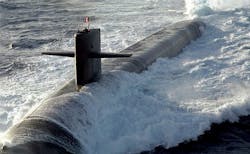Draper Lab to provide additional guidance systems for Trident submarine-launched nuclear missiles
Officials of the Navy Strategic Systems Program office in Washington announced a potential $391.8 million contract to Draper Lab on Friday to build more Trident (D5) MK 6 guidance equivalent units. This contract initially is for $191.1 million, and has options that could increase its value to $391.8 million.
The Navy's Trident II D5 nuclear missiles are designed for launch from Ohio-class ballistic missile submarines, from the Navy's future Columbia-class submarine, and from British Royal Navy Vanguard-class ballistic-missile submarines.
The Columbia-class submarine program, which will replace the Ohio-class ballistic missile submarines will begin construction in 2021 and enter service in 2031. From there, the submarine class will serve through 2085.
Related: Navy invests in submarine-launched nuclear ballistic missile guidance upgrades and test
The Trident II nuclear-tipped ballistic missile has a range of more than 7,000 miles and carries four independently targeted 475-kiloton nuclear warheads.
The Trident missile's MK 6 guidance system consists of an electronics assembly with the system's flight computers, and an inertial measurement unit (IMU) with the system's inertial sensors. The electronics assembly interfaces with the submarine's fire-control system and the missile's flight-control electronics assembly. The IMU, meanwhile, senses the motion of missile and provides navigation information to the mission computer.
Trident missiles are aboard 14 Navy Ohio-class submarines and four British Royal Navy Vanguard-class submarines. Each Ohio-class submarine can carry as many as 24 Trident atomic missiles. These vessels together carry about half of all U.S. strategic thermonuclear warheads.
The Draper Lab contract is part of a Navy effort begun in 2002 to extend the life of the D5 missiles to the year 2040 by replacing obsolete components with commercial off-the-shelf (COTS) hardware. Upgrades involved the missile reentry systems and guidance systems.
The first flight test of a D5 extended-life subsystem, the MK 6 Mod 1 guidance system, was in early 2012 aboard the ballistic missile submarine USS Tennessee (SSBN 734).
The Trident nuclear missile has a maximum speed of 13,000 miles per hour, and has precision guidance from inertial sensors with star sighting. No GPS-guided Trident D5 missiles have been deployed.
The Trident II missile warhead discharges the energy of 475,000 tons of TNT, and is roughly 30 times the size of the U.S. nuclear bomb dropped on Hiroshima, Japan, in 1945.
On this contract Draper Lab will do the work in Cambridge and Pittsfield, Mass.; Clearwater, Fla.; and McKinney, Texas, and should be finished by July 2022. For more information contact Draper Lab online at www.draper.com, or the Navy Strategic Systems Programs Office at www.ssp.navy.mil.
Ready to make a purchase? Search the Military & Aerospace Electronics Buyer's Guide for companies, new products, press releases, and videos
